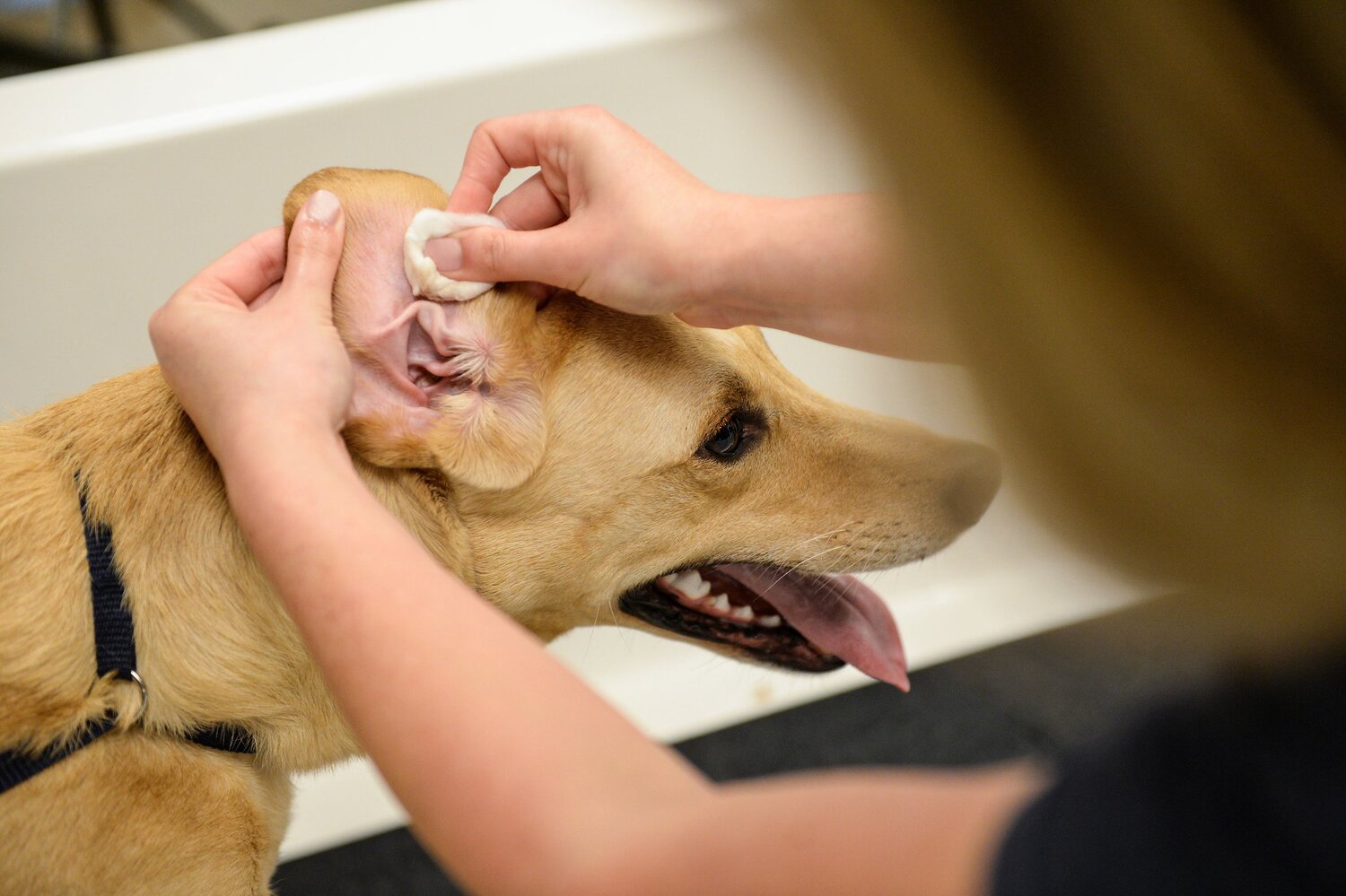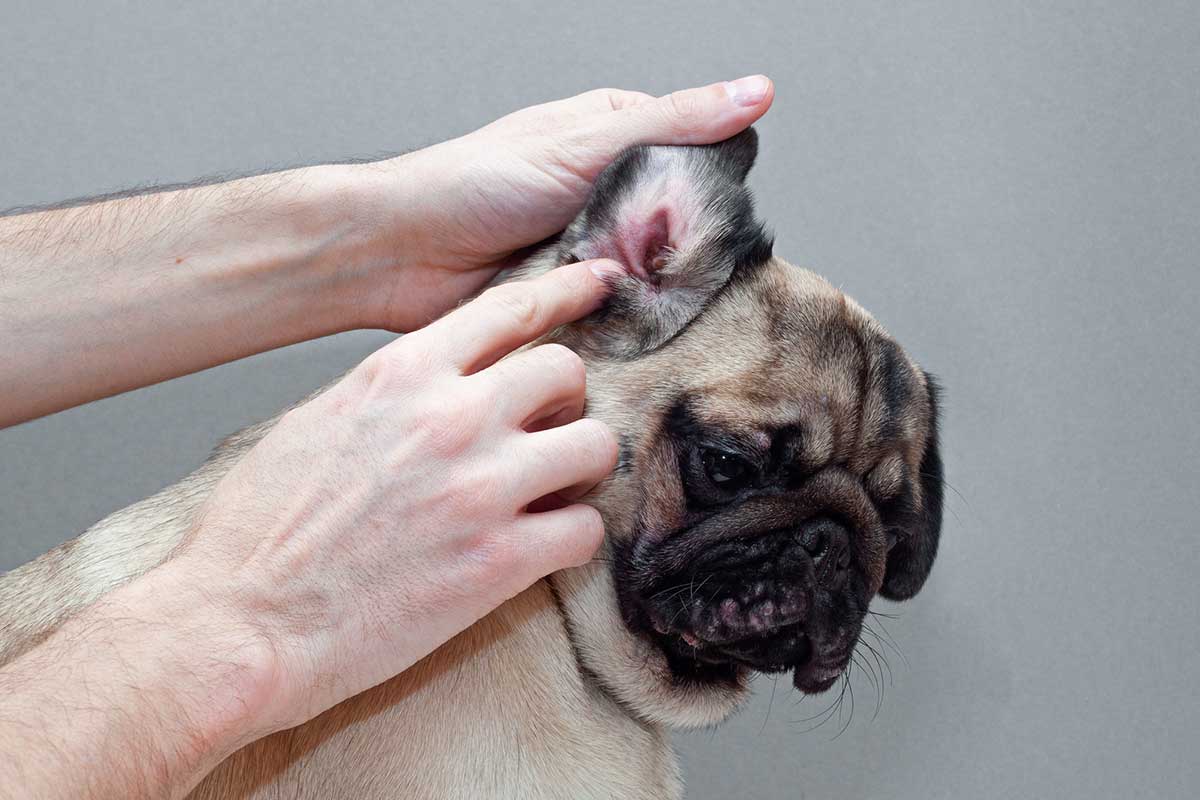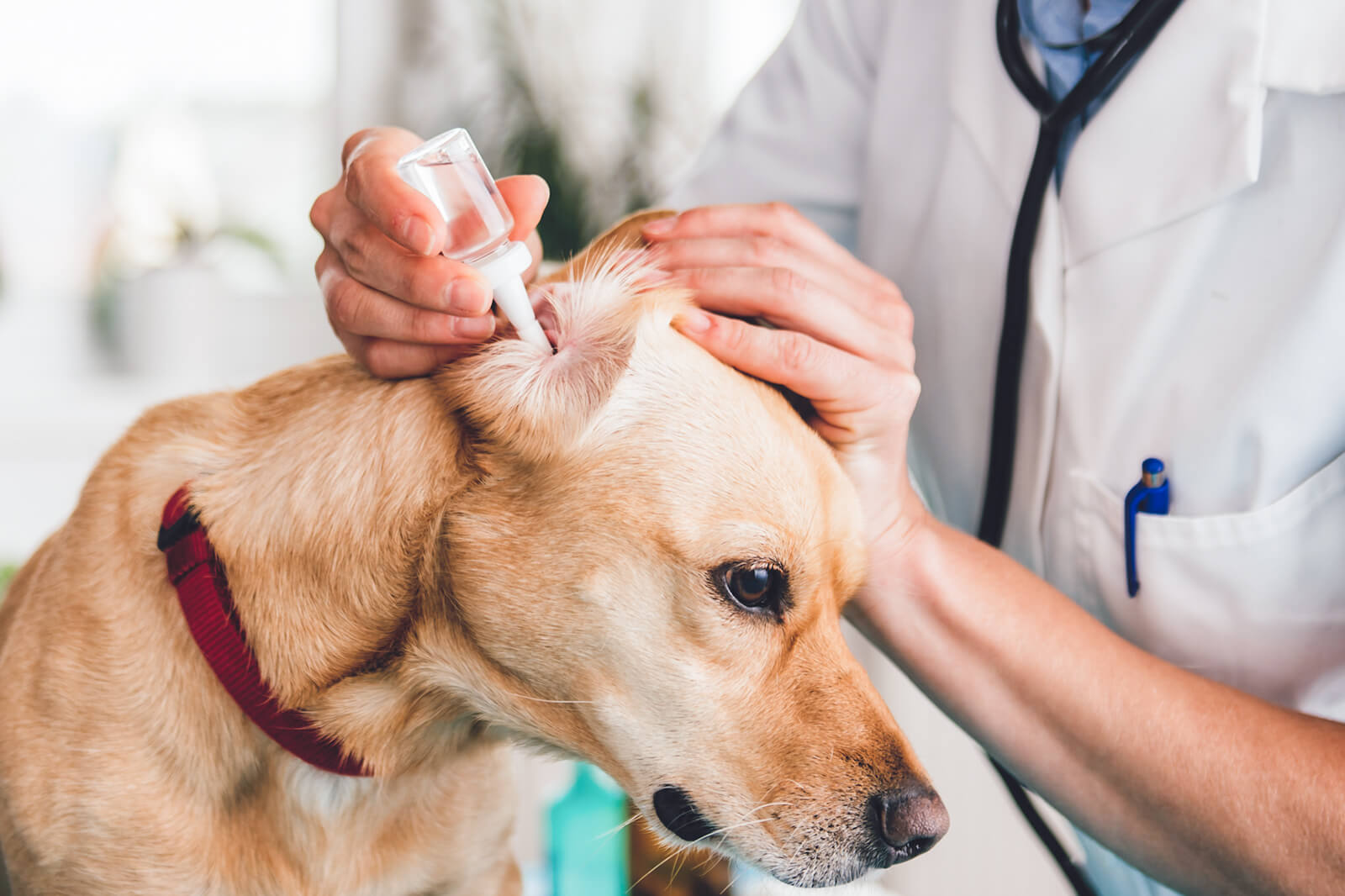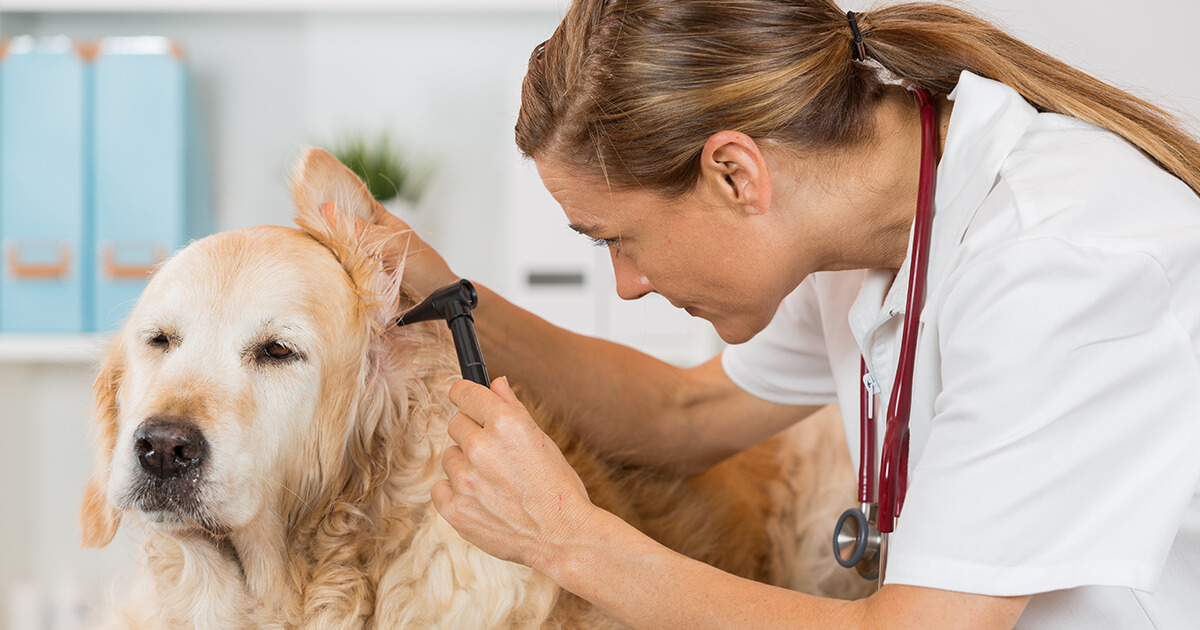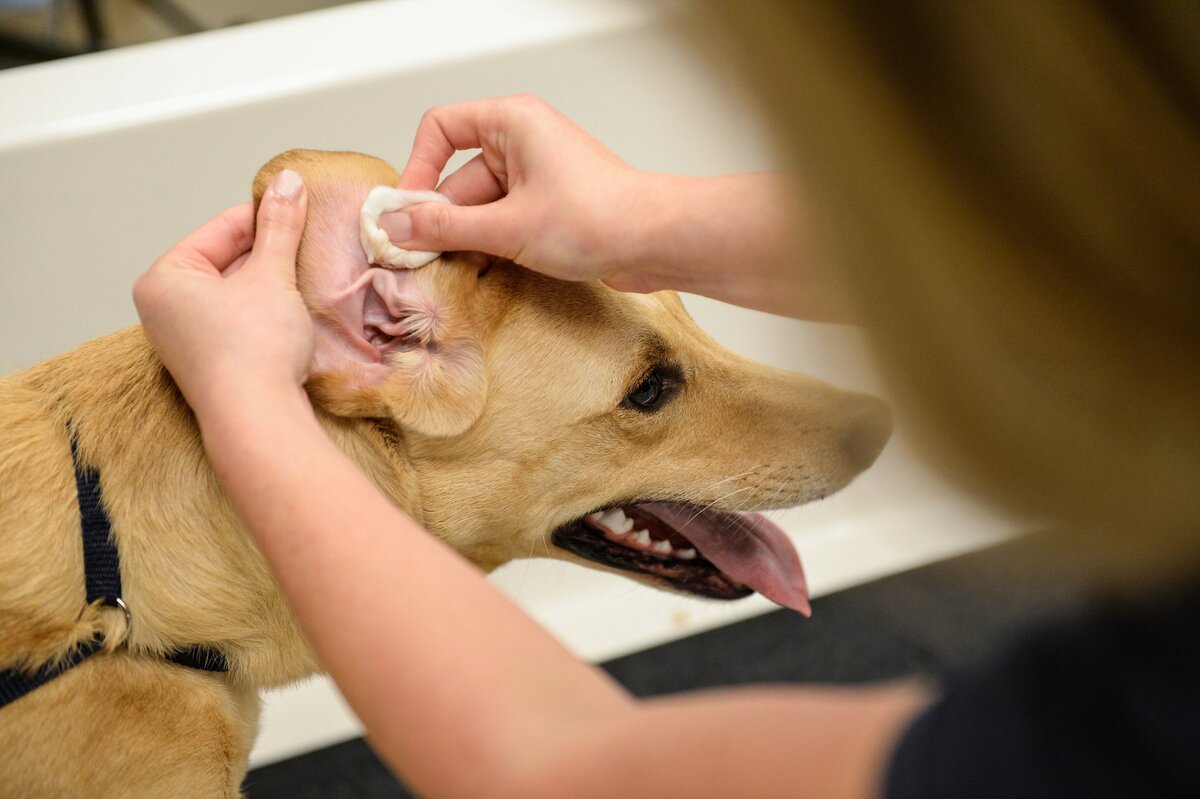Home>Health & Wellness>Common Health Issues>Eye and Ear Health>What To Treat A Dog’s Ear Infection With
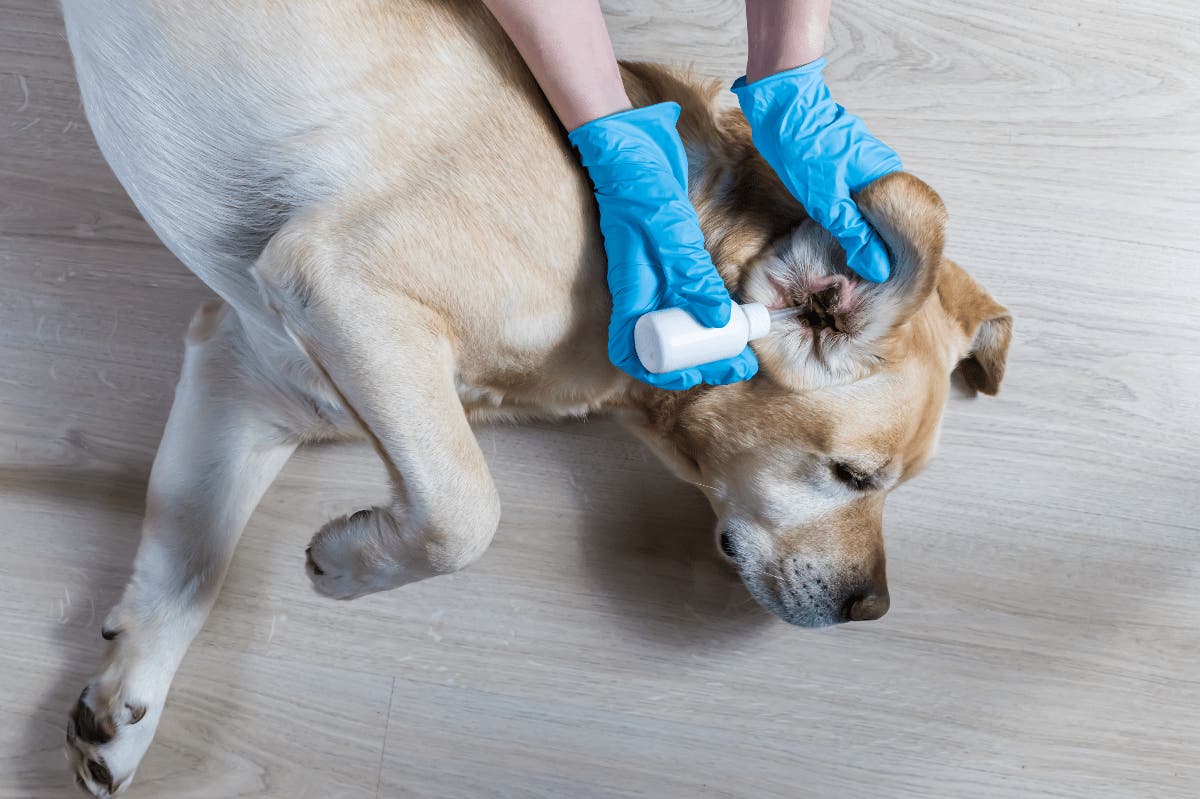

Eye and Ear Health
What To Treat A Dog’s Ear Infection With
Modified: February 21, 2024
Discover effective treatments for your dog's ear infection and maintain their eye and ear health with expert advice and tips. Learn how to care for your pet's ears and prevent future issues.
(Many of the links in this article redirect to a specific reviewed product. Your purchase of these products through affiliate links helps to generate commission for Pawsomeoldies.com, at no extra cost. Learn more)
Table of Contents
Introduction
Ear infections are a common health issue among dogs, causing discomfort and distress. As a responsible pet owner, it's crucial to be well-informed about the causes, symptoms, and treatment options for dog ear infections. By understanding these aspects, you can provide the necessary care and support to your furry companion, ensuring their well-being and happiness.
In this comprehensive guide, we will delve into the intricacies of dog ear infections, shedding light on the symptoms, causes, diagnosis, and effective treatment methods. Additionally, we will explore home remedies and medications that can aid in alleviating your dog's ear discomfort. Furthermore, we will discuss preventive measures to minimize the risk of future ear infections, ultimately promoting your dog's overall ear health.
By the end of this article, you will have gained valuable insights into managing and preventing ear infections in dogs, empowering you to take proactive steps in safeguarding your pet's auditory wellness. Let's embark on this enlightening journey to equip ourselves with the knowledge and tools necessary to ensure our furry friends lead a life free from the discomfort of ear infections.
Read more: How To Treat Dog Ear Infection With Steroids
Understanding Dog Ear Infections
Dog ear infections, also known as otitis externa, refer to the inflammation of the outer ear canal. This condition can be extremely uncomfortable for dogs and may lead to significant distress if left untreated. Understanding the underlying factors and symptoms of dog ear infections is crucial for prompt intervention and effective management.
When a dog experiences an ear infection, it typically involves the outer ear canal, which extends from the visible part of the ear to the eardrum. The ear canal's warm and moist environment provides an ideal breeding ground for bacteria, yeast, and other microorganisms, leading to the development of infections.
Several factors can contribute to the onset of ear infections in dogs. These include allergies, excessive moisture or wax buildup in the ear canal, foreign objects lodged in the ear, and anatomical factors such as floppy ears that impede proper air circulation. Additionally, dogs with a history of skin conditions or those prone to swimming may be more susceptible to ear infections.
Recognizing the symptoms of dog ear infections is essential for early detection and intervention. Common indicators of this condition include persistent scratching or pawing at the ears, head shaking, foul odor emanating from the ears, redness or swelling of the ear canal, and abnormal discharge, which may appear as a dark, waxy substance.
Furthermore, dogs experiencing ear discomfort may display behavioral changes, such as irritability or reluctance to have their ears touched. It's important to note that untreated ear infections can lead to more severe complications, including ear hematomas, in which blood accumulates within the ear flap, and potential damage to the eardrum.
By gaining a comprehensive understanding of dog ear infections, pet owners can remain vigilant for potential signs of this condition and take proactive measures to address it. Through attentive observation and prompt veterinary care, the impact of ear infections on a dog's well-being can be minimized, allowing them to lead a comfortable and fulfilling life.
Symptoms of Dog Ear Infections
Identifying the symptoms of dog ear infections is pivotal in ensuring timely intervention and effective management of this common health issue. Dogs affected by ear infections may exhibit a range of noticeable indicators, signaling discomfort and the need for prompt attention.
One of the most prevalent symptoms of dog ear infections is persistent scratching or pawing at the ears. This behavior is often accompanied by head shaking, as dogs attempt to alleviate the discomfort caused by the infection. Additionally, dogs may tilt or hold their heads at an unusual angle, indicating discomfort within the affected ear.
Foul odor emanating from the ears is another telltale sign of a potential ear infection. This odor is often distinct and unpleasant, serving as a clear indicator of an underlying issue. Furthermore, redness or swelling of the ear canal may be observed upon close inspection, signaling inflammation and the presence of an infection.
Abnormal discharge from the ears is a common symptom of ear infections in dogs. This discharge may manifest as a dark, waxy substance, indicating the presence of bacteria or yeast within the ear canal. The consistency and color of the discharge can vary, providing valuable insights into the nature and severity of the infection.
Behavioral changes can also serve as indicators of ear discomfort in dogs. Irritability, reluctance to have their ears touched, and signs of discomfort when the ears are manipulated are all potential behavioral symptoms of ear infections. Additionally, dogs may vocalize distress or exhibit signs of agitation, signaling their discomfort and the need for intervention.
It's important to note that the manifestation of these symptoms may vary based on the severity and underlying cause of the ear infection. Some dogs may exhibit multiple symptoms, while others may display a select few. By remaining attentive to these indicators and seeking veterinary guidance when necessary, pet owners can ensure that their furry companions receive the care and support needed to address ear infections effectively.
By recognizing and understanding the symptoms of dog ear infections, pet owners can play a proactive role in safeguarding their dog's auditory wellness, promoting their overall comfort and quality of life.
Causes of Dog Ear Infections
Dog ear infections can stem from various underlying factors, each contributing to the development of this uncomfortable and distressing condition. By understanding the primary causes of ear infections in dogs, pet owners can take proactive measures to mitigate these factors and minimize the risk of their furry companions experiencing this common health issue.
One of the leading causes of dog ear infections is the presence of moisture or excessive wax buildup within the ear canal. Dogs with floppy ears or those that frequently engage in activities involving water, such as swimming, are particularly susceptible to moisture accumulation in their ear canals. This moisture creates an ideal environment for the proliferation of bacteria and yeast, leading to the onset of infections.
Allergies, whether environmental or food-related, can also contribute to the development of ear infections in dogs. Allergic reactions can trigger inflammation and irritation within the ear canal, paving the way for the colonization of microorganisms that instigate infections. Identifying and addressing the underlying allergies can play a pivotal role in preventing recurrent ear infections in dogs.
Foreign objects lodged in the ear can instigate irritation and inflammation, potentially leading to the onset of an infection. Dogs, especially those with inquisitive tendencies, may inadvertently introduce foreign matter into their ear canals, necessitating prompt removal to prevent the escalation of discomfort and the development of infections.
Anatomical factors, such as the shape and size of a dog's ears, can also contribute to the likelihood of ear infections. Breeds with floppy or densely-haired ears may experience reduced air circulation within the ear canal, creating an environment conducive to the growth of microorganisms. Additionally, dogs with narrow ear canals may be more prone to wax buildup, further increasing the risk of infections.
Furthermore, underlying skin conditions, such as dermatitis or eczema, can extend to the ears, leading to inflammation and susceptibility to infections. Dogs with a history of skin issues may require specialized care to manage these conditions effectively and minimize their impact on ear health.
By addressing these underlying causes and taking proactive measures to mitigate their effects, pet owners can significantly reduce the likelihood of their dogs experiencing ear infections. Through attentive care, regular ear inspections, and prompt veterinary intervention when necessary, the impact of these causes can be mitigated, promoting the auditory wellness and overall comfort of canine companions.
Diagnosing Dog Ear Infections
Diagnosing dog ear infections requires a comprehensive approach that encompasses both clinical evaluation and diagnostic procedures. Veterinary professionals employ a combination of visual examination, physical assessment, and, in some cases, laboratory tests to accurately diagnose and characterize ear infections in dogs.
During a veterinary consultation, the initial step in diagnosing a dog's ear infection involves a thorough visual examination of the affected ear. The veterinarian carefully inspects the ear canal for signs of inflammation, redness, swelling, and the presence of discharge. Additionally, the veterinarian may utilize an otoscope, a specialized instrument that allows for the visualization of the ear canal's internal structures, enabling a detailed assessment of the extent and nature of the infection.
Physical assessment plays a crucial role in diagnosing ear infections, as it allows the veterinarian to evaluate the dog's overall ear health and identify any predisposing factors, such as anatomical abnormalities or excessive wax buildup. By palpating the ear and observing the dog's behavioral responses, the veterinarian can gauge the level of discomfort and assess the severity of the infection.
In some instances, the veterinarian may collect a sample of the ear discharge for further analysis. This sample can be subjected to microscopic examination to identify the presence of bacteria, yeast, or other microorganisms, providing valuable insights into the specific pathogens contributing to the infection. Additionally, a culture and sensitivity test may be conducted to determine the most effective treatment approach, particularly in cases of recurrent or resistant infections.
Furthermore, diagnostic imaging, such as radiography or advanced imaging techniques like computed tomography (CT) scans, may be employed in complex or severe cases to assess the extent of tissue involvement and identify any underlying anatomical abnormalities that could exacerbate the infection.
By employing a multifaceted approach to diagnosis, veterinary professionals can accurately assess the nature and severity of a dog's ear infection, laying the foundation for targeted and effective treatment. This comprehensive diagnostic process enables pet owners to gain a clear understanding of their dog's condition and facilitates the implementation of tailored treatment strategies to alleviate discomfort and promote optimal ear health.
Treating Dog Ear Infections
Treating dog ear infections necessitates a multifaceted approach aimed at alleviating discomfort, eradicating the underlying infection, and promoting optimal ear health. The treatment regimen is tailored to the specific nature and severity of the infection, with the overarching goal of restoring the affected dog's auditory wellness.
The primary step in treating dog ear infections involves thorough ear cleaning to remove accumulated debris, discharge, and any foreign matter that may exacerbate the infection. This process is carried out meticulously to ensure the elimination of potential irritants and to create an environment conducive to healing. Veterinary professionals employ specialized ear cleansers and gentle techniques to cleanse the ear canal effectively, promoting the resolution of the infection.
In cases where the ear infection is accompanied by significant inflammation and discomfort, veterinarians may administer anti-inflammatory medications to alleviate pain and reduce swelling. These medications aid in enhancing the dog's comfort while facilitating the efficacy of subsequent treatment measures.
Antibiotic or antifungal medications are often prescribed to target the specific pathogens responsible for the ear infection. These medications may be administered orally, topically, or via ear drops, depending on the nature and severity of the infection. The selection of the appropriate medication is guided by the results of diagnostic tests and the veterinarian's assessment, ensuring targeted and effective treatment.
For dogs with recurrent or chronic ear infections, a comprehensive treatment plan may encompass systemic therapies to address underlying predisposing factors, such as allergies or anatomical abnormalities. This holistic approach aims to minimize the likelihood of future infections and promote sustained ear health.
Throughout the treatment process, pet owners play a crucial role in ensuring compliance with the prescribed medications and treatment protocols. Consistent administration of medications, adherence to cleaning routines, and diligent monitoring of the dog's response to treatment are essential for achieving favorable outcomes.
Regular follow-up appointments with the veterinarian allow for ongoing assessment of the dog's progress and the adjustment of treatment strategies as necessary. This proactive approach enables timely intervention and optimization of the treatment plan, ultimately fostering the resolution of the ear infection and the restoration of the dog's ear health.
By embracing a comprehensive and tailored treatment approach, pet owners can effectively address dog ear infections, providing their furry companions with the care and support needed to overcome this common health issue and enjoy a life free from the discomfort of ear infections.
Home Remedies for Dog Ear Infections
Home remedies can complement veterinary treatment in managing dog ear infections, offering natural and soothing interventions to alleviate discomfort and promote ear health. While these remedies can provide relief, it's essential to consult with a veterinarian before implementing them, ensuring they align with the specific needs of the affected dog.
-
Hydrogen Peroxide Solution: A diluted solution of hydrogen peroxide and water can be used to gently cleanse the ear canal. This solution helps dislodge debris and minimize the presence of infectious agents, contributing to a cleaner and more conducive environment for healing.
-
Organic Apple Cider Vinegar: Organic apple cider vinegar, when appropriately diluted with water, can serve as an effective ear cleanser. Its natural antibacterial and antifungal properties make it a valuable ally in combating ear infections, while its acidic nature helps maintain an optimal pH balance within the ear canal.
-
Coconut Oil: Coconut oil possesses antimicrobial properties and can be utilized to soothe and moisturize the ear canal. When applied in moderation, coconut oil aids in reducing inflammation and provides a protective barrier against potential irritants.
-
Warm Compresses: Gentle warmth can alleviate discomfort and promote circulation within the affected ear. Applying a warm, damp cloth to the outer ear can provide soothing relief, easing the dog's discomfort and fostering a conducive environment for healing.
-
Herbal Infusions: Herbal infusions, such as chamomile or calendula tea, can be used to create soothing ear rinses. These infusions possess anti-inflammatory and antimicrobial properties, offering a natural and gentle approach to supporting ear health.
-
Dietary Adjustments: In cases where underlying allergies contribute to ear infections, dietary modifications may play a pivotal role in managing the condition. Consultation with a veterinarian can aid in identifying potential dietary triggers and formulating an appropriate nutritional plan to support ear health.
While these home remedies can offer valuable support, it's crucial to exercise caution and seek professional guidance to ensure their safe and effective application. By integrating these natural interventions with veterinary care, pet owners can play an active role in promoting their dog's ear health and well-being.
Medications for Dog Ear Infections
Medications play a pivotal role in the comprehensive treatment of dog ear infections, targeting the specific pathogens responsible for the condition and alleviating associated discomfort. Veterinary professionals may prescribe a range of medications tailored to the nature and severity of the infection, with the overarching goal of eradicating the causative agents and promoting optimal ear health.
Antibiotic medications are commonly employed to combat bacterial infections within the dog's ear canal. These medications may be administered orally, topically, or in the form of ear drops, depending on the extent of the infection and the veterinarian's assessment. Oral antibiotics are effective in addressing systemic bacterial infections, while topical formulations and ear drops deliver targeted treatment directly to the affected area, maximizing efficacy and minimizing potential side effects.
In cases where yeast or fungal infections are identified, antifungal medications are prescribed to combat these specific pathogens. These medications may be administered in conjunction with ear cleaning procedures to eliminate the infectious agents and create an environment conducive to healing. Antifungal medications are available in various forms, including topical creams, ointments, and ear drops, allowing for tailored treatment based on the individual dog's needs.
Additionally, anti-inflammatory medications may be prescribed to alleviate pain, reduce swelling, and enhance the dog's comfort during the course of treatment. By addressing inflammation within the ear canal, these medications contribute to the overall management of the infection, promoting the dog's well-being and facilitating the efficacy of other treatment measures.
For dogs with recurrent or chronic ear infections, systemic therapies may be recommended to address underlying predisposing factors, such as allergies or anatomical abnormalities. These comprehensive treatment approaches aim to minimize the likelihood of future infections and promote sustained ear health, addressing the root causes of the condition and fostering long-term well-being.
It's essential for pet owners to adhere to the prescribed medication regimen, ensuring consistent administration and diligent monitoring of the dog's response to treatment. Regular follow-up appointments with the veterinarian enable ongoing assessment of the dog's progress, allowing for adjustments to the treatment plan as necessary to optimize outcomes and promote the resolution of the ear infection.
By embracing a multifaceted approach to medication-based treatment, pet owners can effectively address dog ear infections, providing their furry companions with the care and support needed to overcome this common health issue and enjoy a life free from the discomfort of ear infections.
Preventing Dog Ear Infections
Preventing dog ear infections is a proactive endeavor that involves attentive care, regular maintenance, and the implementation of preventive measures to minimize the risk of this common health issue. By adopting a holistic approach to ear health, pet owners can significantly reduce the likelihood of their furry companions experiencing the discomfort and distress associated with ear infections.
Regular ear inspections play a pivotal role in early detection and prevention of ear infections. By routinely examining the dog's ears for signs of redness, swelling, or abnormal discharge, pet owners can identify potential issues at their onset, enabling prompt intervention and effective management. Additionally, maintaining proper ear hygiene through gentle cleaning and removal of excess wax and debris helps create an environment less conducive to the development of infections.
Ensuring that the dog's ears remain dry is essential in preventing moisture-related ear infections. Drying the ears thoroughly after swimming or bathing, especially for breeds prone to moisture accumulation, minimizes the risk of bacterial and yeast growth within the ear canal. Additionally, using ear drying solutions specifically formulated for dogs can aid in maintaining optimal ear hygiene and reducing the likelihood of infections.
Regular grooming, including the careful trimming of excess hair around the ears, promotes adequate air circulation and minimizes the accumulation of debris and moisture. This grooming practice is particularly beneficial for breeds with dense or long ear hair, reducing the potential for irritants and infectious agents to thrive within the ear canal.
Dietary considerations can also play a role in preventing ear infections, especially in cases where underlying allergies contribute to the condition. Identifying potential dietary triggers and formulating a nutritionally balanced diet tailored to the dog's specific needs can mitigate the impact of allergies, reducing the likelihood of allergic reactions that may manifest as ear infections.
Furthermore, seeking prompt veterinary care for any signs of ear discomfort or abnormalities is crucial in preventing the escalation of potential issues. Veterinary professionals can provide valuable guidance on preventive strategies, conduct thorough ear examinations, and offer insights into breed-specific predispositions to ear infections, empowering pet owners to take proactive measures in safeguarding their dog's ear health.
By integrating these preventive measures into a comprehensive care routine, pet owners can create an environment that promotes optimal ear health, minimizing the likelihood of their dogs experiencing the discomfort and distress of ear infections. Through attentive care, regular maintenance, and proactive interventions, pet owners can play a proactive role in ensuring their furry companions lead a life free from the burden of ear infections.
Read more: What Causes A Yeast Ear Infection In Dogs
Conclusion
In conclusion, dog ear infections are a prevalent and distressing health issue that can significantly impact a dog's well-being. By gaining a comprehensive understanding of the causes, symptoms, diagnosis, and treatment options for ear infections, pet owners can play a proactive role in safeguarding their furry companions' auditory wellness. The recognition of symptoms such as persistent scratching, head shaking, foul odor, and discharge from the ears empowers pet owners to seek timely veterinary care, facilitating early intervention and effective management of ear infections.
Furthermore, the multifaceted approach to treatment, encompassing thorough ear cleaning, targeted medications, and holistic interventions, underscores the importance of addressing ear infections comprehensively. By embracing home remedies and medications under veterinary guidance, pet owners can provide their dogs with the care and support needed to overcome ear infections and enjoy a life free from discomfort.
Preventive measures, including regular ear inspections, maintenance of ear hygiene, and grooming practices, are instrumental in minimizing the risk of ear infections. Additionally, dietary considerations and prompt veterinary care play pivotal roles in preventing the escalation of potential issues, fostering an environment that promotes optimal ear health.
By integrating these insights and strategies into their approach to pet care, pet owners can ensure that their furry companions lead comfortable and fulfilling lives, free from the burden of ear infections. Through attentive care, proactive interventions, and a deep commitment to their dogs' well-being, pet owners can make a meaningful difference in safeguarding their pets' auditory wellness, ultimately strengthening the bond between humans and their canine companions.
